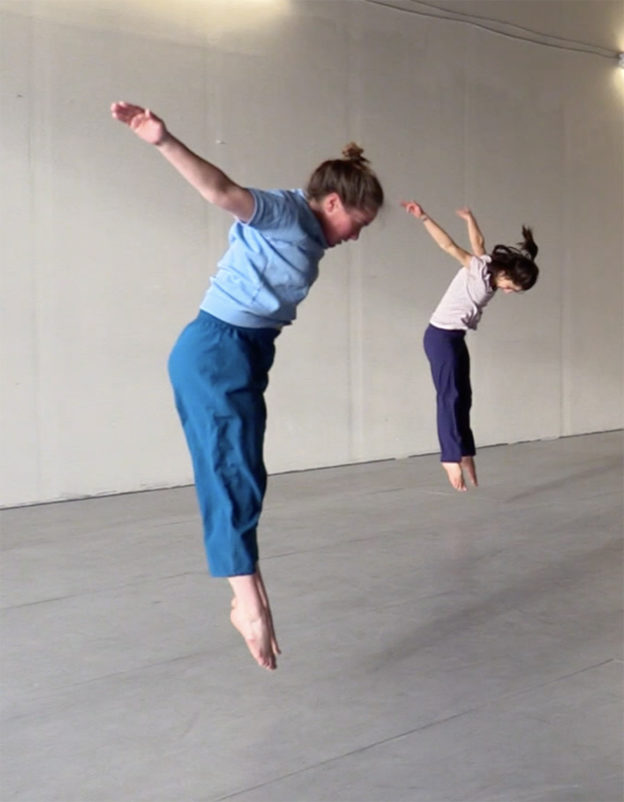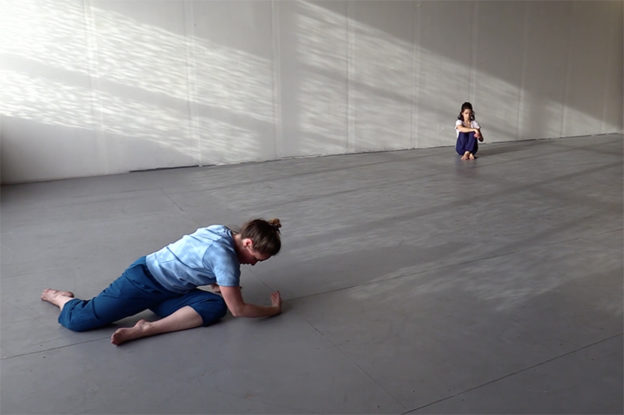As a movement-based artist, my work is sustained and perpetuated by the dynamic interchange which occurs between practices of noticing, investigating, and distilling. I’m an avid observer of the human condition posing as a choreographer. I’m currently interested in researching strategies which undermine habitual choice making, and inviting ambiguity and comfortability with the unknown as a deliberate performative state. I’m interested in framing the activities of the moving body with an allowance of its multiplicitous nature. Along these lines I find myself increasingly interested in score-based practices as a way to generate material as well as a way to tune and train my body and mind. I define score as the environment which creates the conditions for tracking a direct relationship with space, time, the senses, the materials, and one’s perceptual experience of this interchange. The score is alive.
When I say the word “score” to myself, it automatically conjures a visual image of a web. Within this web or network I cultivate a practice of mapping particulars as landmarks toward which I can tune my perceptual experience. There are particulars that might include directions for the body, the senses, directions in space and time. I have a sense of working with score as a simultaneous experience of micro and macro. It’s a way of getting in touch with nature, not as an imagined or projected experience or place outside of myself, but as an experience that, like the natural world, doesn’t desire to be anything other than what it is. I’m looking to create conditions that allow for this. A score is a structure on which to rest or lean into and in so doing perhaps access an experience of a decentralized self. It isn’t me that I’m doing or showing. It’s the score. Yes, I’m responsible for my participation in it or in relationship to it, but the yielding to the container of the score grants a kind of disassociation from the need to assert an identity in the usual way. Then another kind of being or doing is possible. In my experience the agency of each performer is amplified through directives that invite individual aesthetics, choice. A tuning to the present that allows for our perception of what we are performing, or practicing performing, to be inherently inclusive of the unknown.

The question of “what is choreography” is not a new one or a particularly interesting one, but because there isn’t one answer to the question, rather than invite an answer it invites musings of a multitude of possible answers to the question. Namely, there are an infinite number of ways to construct a dance, and it is useful to re-examine and re-investigate this terrain with each creative process.
What does it mean to get in a room with people and move together with the intention of “making” something? How does the culture we create in rehearsal process impact the “finished product”? It’s a strange phenomenon—the rehearsal process—and for most dance artists the time spent in rehearsal greatly outnumbers the time spent in performance. And yet, to the greater public, this notion of rehearsal culture remains mysterious, and even to many dance artists laden with a history of presumed roles, power structures, and behaviors. As a dancer you commit your time, your skill, your intelligence, and your physical attendance in service of the project. This isn’t questioned. It’s a given. Dancers expect this. But what does it actually mean? And what is being assumed? I find myself questioning: what is the nature of the assumptions of the dancer/choreographer relationship and how can we as artists be in more active contemplation of the culture we engender in our creative processes? What do we want to do here? Why are we here? Are our reasons symbiotic? Who are we serving and who is being served? What is the line between design and domination? Who gets to choose? Does everyone in the room feel empowered? Valued? Who ultimately owns the work if it’s been created collectively? In dialogue with friend and colleague Christy Funsch (with whom I have spent countless hours in creative process and dialogue), she put it aptly:
“Rehearsal culture and the state of the working room are too often assumed to be agreed-upon constructs… . . . What if we were as bold and imaginative in our methodologies as we are with our content? Who makes the work, who is the work, where does the work reside if not in the bodies and minds of those enacting it?”
Dances cannot be relics or museum pieces as they are not objects but rather lived experiences. Even the most historical dances, in the performance of them, are created anew by the bodies enacting the choreography, no matter how tightly prescribed it may be. So then it might follow that a dance is a type of communal property.
I do believe that as artists we are made by and evolve through our making activities. How does the rehearsal process function as a microcosm for the way we wish the world to function? Often in my experience with creating new work the time spent in rehearsal versus performance is probably 30 to 1. So what are these minutes, hours, days, weeks, months comprised of and how do they have meaning in and of themselves regardless or even in spite of the outcome of the final product, AKA “the performance”? The politics we espouse in the world are reflected in the way we operate in our most intimate environments, and I include the rehearsal space to be in this category. Can we employ practices in our rehearsal processes that blow open conventions in the same way we’d like our work to function?
In my current process I have felt my notions of what it means to be productive have shifted. I wanted to spend time with these people (Arletta Anderson, Deborah Karp, Phoenicia Pettyjohn, and Karla Quintero) doing and being and talking and moving. I have felt the space of this creative process as a field in which to have exchanges – intellectual, physical, emotional. As we move closer to the performance event, I find myself considering how the end “product” of the dance is somehow a container or catch all for all the time we’ve spent together. And the residue of all the time spent, regardless of the material we have distilled into the piece, is present in the work as held by each person’s sense of history and memory, and the relationality between us. The piece exists as a document of our cumulative time spent together, a sort of spatio-temporal living bricolage.

My desire in making this current work was to direct in such a way that in this constellation of people each person is very much individuated and distinct in the world of the piece. Within this environment we are consensually co-existing. How can each woman be navigating the multiplicity of her own inner world(s) and bodily expressions and also be in this collective activity? How does the environment, the sound score and eventually the presence of an audience support this?
Then there is the question of how the body is “prepared” (like an instrument) to perform the work. This brings to mind John Cage’s prepared pianos, that were made to alter the possible sounds and combinations of sounds available from the instrument. To me this is also what we do in rehearsal – it’s not just about practicing the material, but about cultivating a shared culture that is specific to this particular dance and we are all innately co-creators in this. How can our rehearsal practices prepare us, or tune us not to attach to a previous precious iteration but to allow for multiple iterations to co-exist and thus inform one another as multiple but equally valued experiences? My work with score and scoring has helped facilitate this possibility.
I believe there is limitless potential for each creative process to be an opportunity for reinvention and rejuvenation, brought forth through a continuous reinvigoration of our rehearsal and performance practices. I don’t know if I even know what all of this means yet, but even just the curiosity and the acknowledgement of the need to practice this kind of examination feels radical and necessary.
This article appeared in the November 2018 edition of In Dance.

